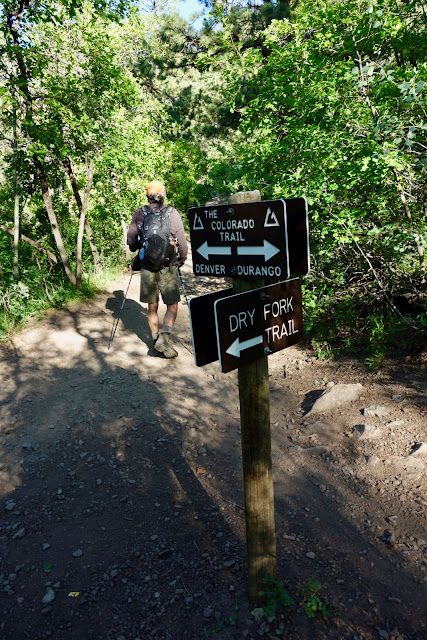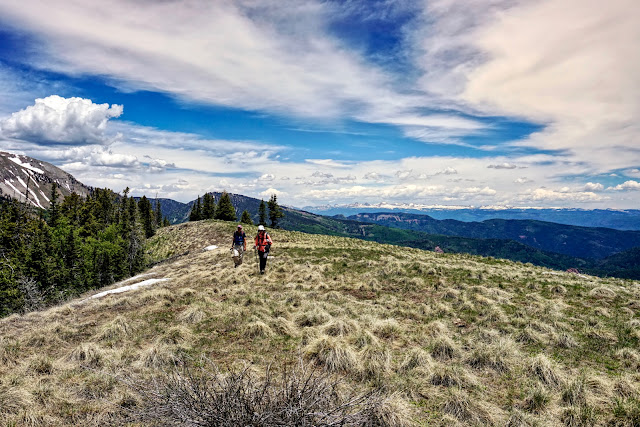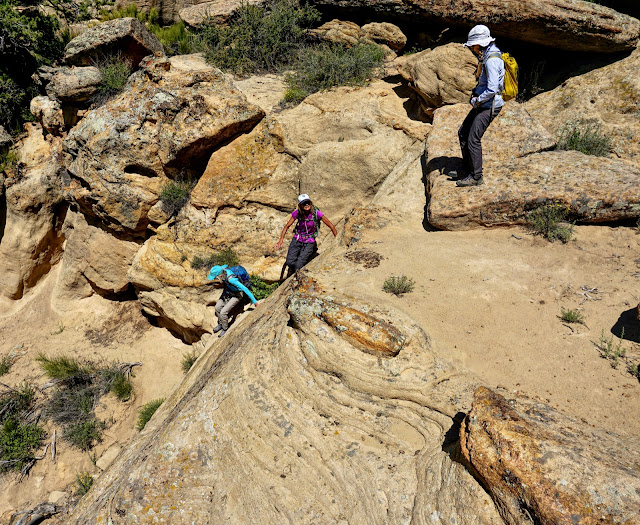Travel to Dry Fork Loop Trailhead: Start measuring from the US 550/160 intersection in Durango. Travel 3.3 miles on US 160 West and turn right on Lightner Creek Road, La Plata County Road 207. At 4.3 miles, turn right onto Dry Fork Road, CR 208, a graded dirt road suitable for all vehicles. Take the right fork at 6.3 miles. At 7.1 miles, a sign for Hoffeins Connection Trail directs left into a large dirt lot.
Distance and Elevation: Dry Fork Loop is 9.1 miles, 1,500 feet of elevation gain; High Point spur adds 7.0 miles round trip and 1,000 feet of vertical; Peak 9,589' adds 0.6 mile round trip with 550 feet of climbing.
Total Time: 3:00 to 5:00 for loop; add about 3:00 for High Point and Peak 9,589'
Difficulty: Trail; off-trail to Peak 9,589'; navigation easy; no exposure
Maps: Durango West; Monument Hill, Colorado 7.5' USGS Quads, or Apogee Mapping; Trails Illustrated No. 144, Durango, Cortez
Winter Closure, December 1 through April 15: The land on both sides of CR 208 is within Perins Peak State Wildlife Area. Public access is prohibited during the closure period which is intended to protect wintering big-game and spring-nesting peregrine falcons. While Dry Fork Loop is on U.S. Forest Service property, the access road and parking lot are in the Perins Peak SWA. The closure on the east side of CR 208 is extended through July 31. This includes the Dry Gulch Trail and Perins Peak.
Poem:
Look, the trees
are turning
their own bodies
into pillars
of light,
are giving off the rich
fragrance of cinnamon
and fulfillment. Mary Oliver (1935-2019)
A simple wooden sign announces the Dry Fork Trail, a roll-bar ramp crosses the cattle guard, a weathered red fence swings open for hikers, and a dirt trail wanders off toward Silver Mountain in the La Plata range. The trailhead is classic American West.
Route: Hike northwest on the Dry Fork Trail. Mountain bikers typically ride the Dry Fork Loop clockwise; hikers are advised to go counterclockwise. At the junction with Hoffeins Connection turn right. At the juncture with the Colorado Trail (CT) do a short spur to Gudy's Rest and then walk west. Return southeast on the Dry Fork Trail. To add miles take the CT north to High Point, the blue-line route. To summit Peak 9,589' climb the north ridge.
Dry Fork Trail #616
The Dry Fork Trail is four miles long. It begins at the Dry Fork Road and ends at the CT-Junction Creek Trail #553. From the trailhead, elevation 7,380 feet, pass through the gate and enter the San Juan National Forest. The loop is multi-use, enjoyed by hikers, runners, mountain bikers, and equestrians. The lowest point on this hike is the parking lot. You will be going uphill at the front end of the hike no matter how you wrap it. The undulating nature of the uphills makes it about as easy as a climb gets. The image below looks back toward the trailhead. Close by in the southeast is North Perins Peak.
Start climbing gently, cross another hefty roll-bar cattle guard and leave the drainage.
Hoffeins Connection Trail #611
At 0.8 mile, 7,620 feet, reach the junction with Hoffeins Connection Trail # 611. While there is a sign for the Dry Fork Trail which continues on, in 2019 the sign was missing for the Hoffeins 1.3 mile link trail. Mountain bikers conventionally ride the loop clockwise. Walkers and runners are advised to turn right so you have a heads up as bikes approach.
Cross the Dry Fork at 1.0 mile. True to its name this tributary typically carries a small amount of water, if any. Openings in the trees afford nice views of the North Perins Peak and Perins Peak cuesta. Once the snow is gone and the ground warms masses of mule's ears begin flowering.
Colorado Trail - Junction Creek Trail #553
Reach the junction with the CT at 2.1 miles, elevation 8,000 feet. The Junction Creek Trail is the final segment of the 486 mile cross-state trek. The 4,860 foot drop from Kennebec Pass (11,740 feet) to the Junction Creek-Colorado Trailhead (6,880 feet) is the greatest single altitude change on the CT. Turn right for the 0.4 mile roundtrip spur to Gudy's Rest.
For thru-hikers on the CT, Gudy's Rest, located four miles from trail's end, is a celebratory place. A thick plank bench looks out over Junction Creek canyon and the west slopes of Barnes Mountain. Off-image is the town of Durango.
A wooden plaque pays tribute to Gudy Gaskill, the genius and tireless champion of the CT. Durango Trails carries on Gudy's legacy. The trail advocacy organization builds and maintains an ever-growing vast network of trails in the region. In addition to their CT upkeep they are the guardians for every foot of trail on the Dry Fork Loop.
Return to the Hoffeins junction and turn right, staying on the CT.
We found bear and cougar tracks imprinted on the soft dirt path. Flowers were especially plentiful in June of 2019. In addition to lavish and aromatic lupine fields we saw: Rocky Mountain milkvetch, fleabane daisy, stemless evening primrose, wild iris, larkspur and delphinium, serviceberry, snowberry, chokecherry, elderberry, mule's ear, pussy toes, mouse ear chickweed, senecio, white peavine, white violet, white geranium, golden banner, bluebell, Geyer's onion and taper-tip onion, mountain parsley, woods' rose, Rocky Mountain penstemon and toadflax penstemon, cinquefoil, Solomon's seal, bedstraw, meadow rue, clematis, Indian paintbrush, heart leaf arnica, osha, red columbine, and blue columbine. (THW, photo)
Day hikers keep company with old growth ponderosa while strolling along the CT. (THW, photo)
Pass by a magnificent trailside ponderosa and then a fenceline at 3.6 miles. Cross a typically bone-dry north tributary of Dry Fork. Colorado blue spruce, Douglas fir, and aspen are sheltered in the drainage. The track bears south for a short distance. Look afar to Animas City Mountain and the Missionary Ridge Rockfall.
The treadway rounds a southeast ridge and then holds to the 8,600 foot contour west-bound for a mile. Top out at 4.8 miles, elevation 8,660 feet. You can practically reach out and touch Silver Mountain only four miles away as the crow flies. Big boulders bounding the path add interest while descending to a fork of Deep Creek, a principal tributary of Lightner Creek.
Dry Fork Trail
Denver anyone? At 5.1 miles, after a mere 2.6 miles on the CT, this loop hangs a left on the Dry Fork Trail. The High Point spur is described later.
There are a bevy of old roads and signs.
Swing around for a glimpse of the upper slopes of Baldy Peak, the shortest mountain in the La Platas at 10,866 feet. (THW, photo)
In autumn, oak is cloaked in the fiery flaming hues of fall. The trail tracks a log and limb fenceline secured with taught barbed wire. At 8.3 miles, watch for the now familiar junction with Hoffeins Connection. Make a hard right, staying on the Dry Fork Trail. If you miss the turn you'll find yourself on a Möbius strip.
High Point, 9,600 Feet
From the junction of the Dry Fork Trail and the CT it is 3.5 miles to High Point with roughly 1,000 feet of elevation gain. This is a popular spur for mountain bikers and hikers alike. Walking is easy on a smooth dirt single track. The CT swings around the south ridge of forested Peak 9,589' and then bears north. The trail utilizes an old roadbed that was laboriously cleared through a chunky scree field. (THW, photo)
Trees part to reveal the east slopes of Silver Mountain.
Whereas the Dry Fork features ponderosa this segment of trail wanderers through aspen glades. Ferns and snowberry live under the trees.
Round Road End Canyon and soon arrive at High Point. It is located on a left bend just before the CT loses a couple hundred feet to head First Trail Canyon before resuming its climb to Kennebec Pass. Junction Creek is canyon cutting 1,000 below. Junction Creek Road can be seen on the west slope of Barnes Mountain. (THW, photo)
Peer through the trees to see the north end of the East Block of the La Plata Mountains. Pictured below starting on the right is Olga Little Mountain and Peak 12,101', Cumberland Mountain, The Notch, Snowstorm Peak, and Lewis Mountain.
Peak 9,589'
This mountain looks pretty appealing on the topo. It is the highest prominence between Deep Creek and Junction Creek. Our plan was to climb the north ridge to the peak (pictured), traverse over Point 9,421', and continue on the south ridge back to the CT. However, the oak brush was fierce and punishing. The ridge was not open and desirable so we gave up at the saddle between the prominences and dropped steeply west to the trail. If you intend to climb the peak, wear long pants.
Note: In 2020, some friends came at the peak from the south. They climbed north-northwest from the CT to Point 9,421'. Then they avoided the worst of the brush by staying below the ridge on its east side to the summit.
We left the CT not quite two miles south of High Point at 9,040 feet. Brush was intense, there was deadfall to climb over, and the pitch was very steep. We stumbled on a helpful big game trail that went straight up the ridge.
We summited after climbing 550 feet in 0.3 mile. The peak register was placed in June, 2019. From the crest look out over Durango, Raider and Crader Ridges, and Perins Peak.
Rising high across the Lightner Creek watershed is Baldy Peak, Deadwood and Silver Mountains, and Bald Knob. (THW, photo)
















































































